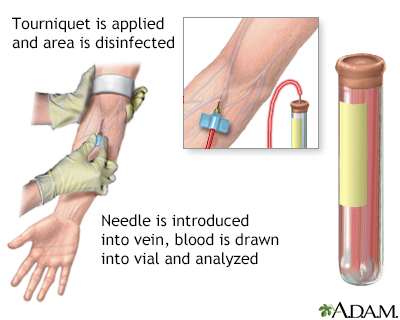BUN - blood test
BUN stands for blood urea nitrogen. Urea nitrogen is what forms when protein breaks down.
A test can be done to measure the amount of urea nitrogen in the blood.
How the Test is Performed
A blood sample is needed. Most of the time blood is drawn from a vein located on the inside of the elbow or the back of the hand.
Drawn from a vein
Venipuncture is the collection of blood from a vein. It is most often done for laboratory testing.

How to Prepare for the Test
Many medicines can interfere with blood test results.
- Your health care provider will tell you if you need to stop taking any medicines before you have this test.
- DO NOT stop or change your medicines without talking to your provider first.
How the Test will Feel
You may feel slight pain or a sting when the needle is inserted. You may also feel some throbbing at the site after the blood is drawn.
Why the Test is Performed
The BUN test is often done to check kidney function.
Normal Results
The normal result is generally 6 to 20 mg/dL.
Note: Normal values may vary among different labs. Talk to your provider about your specific test results.
The examples above show the common measurements for results for these tests. Some laboratories use different measurements or may test different specimens.
What Abnormal Results Mean
Higher-than-normal level may be due to:
- Congestive heart failure
Congestive heart failure
Heart failure is a condition in which the heart is no longer able to pump oxygen-rich blood to the rest of the body efficiently. This causes symptom...
 ImageRead Article Now Book Mark Article
ImageRead Article Now Book Mark Article - Excessive amount of dietary protein in the gastrointestinal tract
- Gastrointestinal bleeding
Gastrointestinal bleeding
Gastrointestinal (GI) bleeding refers to any bleeding that starts in the GI tract. Bleeding may come from any site along the GI tract, but is often d...
 ImageRead Article Now Book Mark Article
ImageRead Article Now Book Mark Article - Hypovolemia (dehydration)
- Heart attack
- Kidney disease, including glomerulonephritis, pyelonephritis, and acute tubular necrosis
- Kidney failure
- Shock
Shock
Shock is a life-threatening condition that occurs when the body is not getting enough blood flow. Lack of blood flow means the cells and organs do n...
 ImageRead Article Now Book Mark Article
ImageRead Article Now Book Mark Article - Urinary tract obstruction
Lower-than-normal level may be due to:
- Liver failure
- Low protein diet
- Malnutrition
- Over-hydration
Considerations
For people with liver disease, the BUN level may be low, even if the kidneys are normal.
Reviewed By
Jacob Berman, MD, MPH, Clinical Assistant Professor of Medicine, Division of General Internal Medicine, University of Washington School of Medicine, Seattle, WA. Also reviewed by David C. Dugdale, MD, Medical Director, Brenda Conaway, Editorial Director, and the A.D.A.M. Editorial team.
Gharavi AG, Landry DW. Approach to the patient with renal disease. In: Goldman L, Cooney KA, eds. Goldman-Cecil Medicine. 27th ed. Philadelphia, PA: Elsevier; 2024:chap 100.
Oh MS, Breifel G, Pincus MR. Evaluation of renal function, water, electrolytes, and acid-base balance. In: McPherson RA, Pincus MR, eds. Henry's Clinical Diagnosis and Management by Laboratory Methods. 24th ed. Philadelphia, PA: Elsevier; 2022:chap 15.
Weisbord SD, Palevsky PM. Prevention and management of acute kidney injury. In: Yu ASL, Chertow GM, Luyckx VA, Marsden PA, Skorecki K, Taal MW, eds. Brenner and Rector's The Kidney. 11th ed. Philadelphia, PA: Elsevier; 2020:chap 29.




